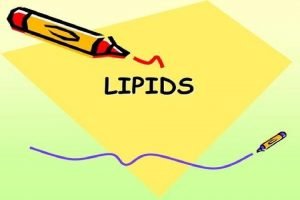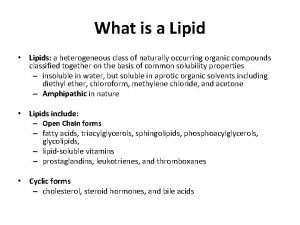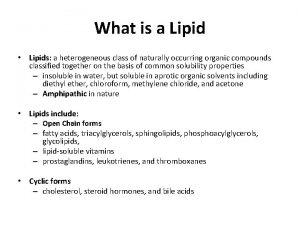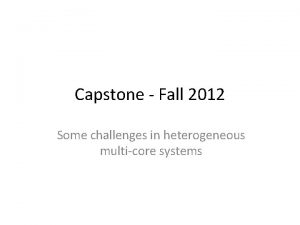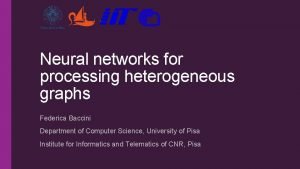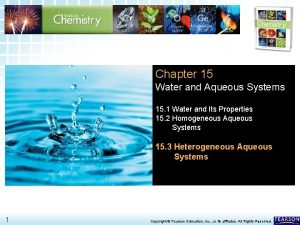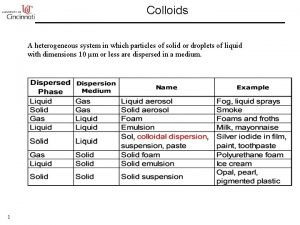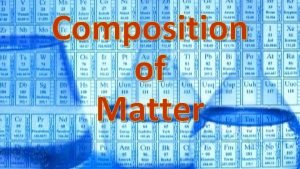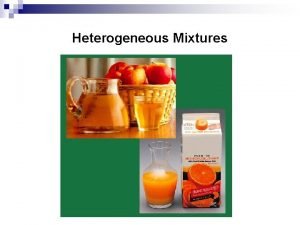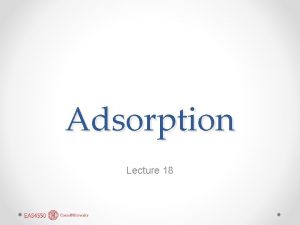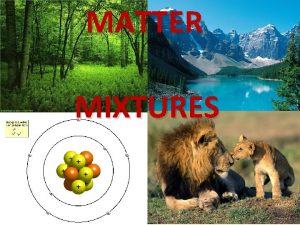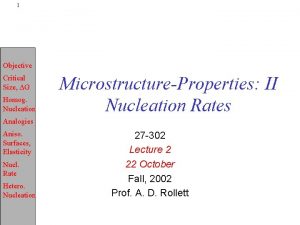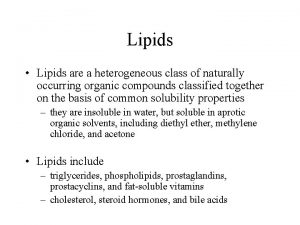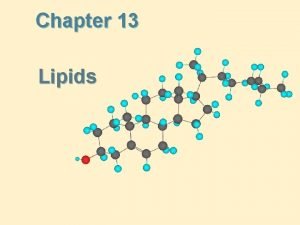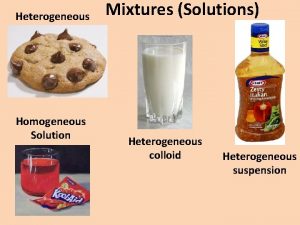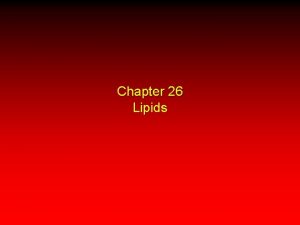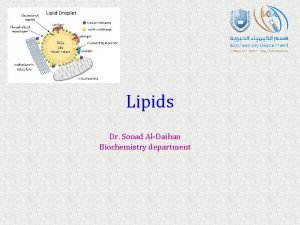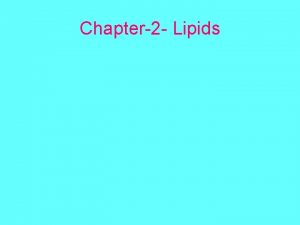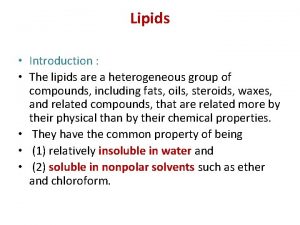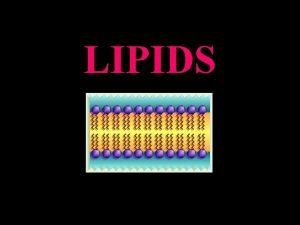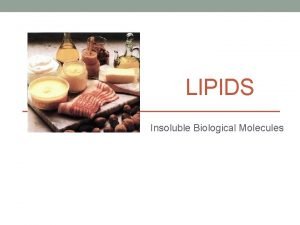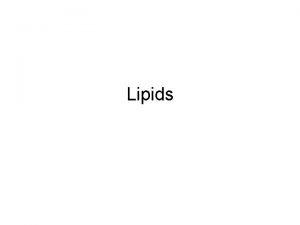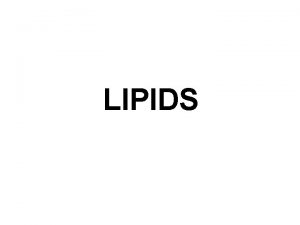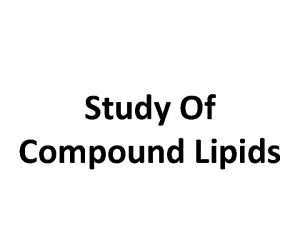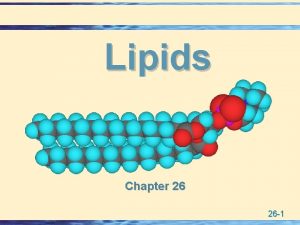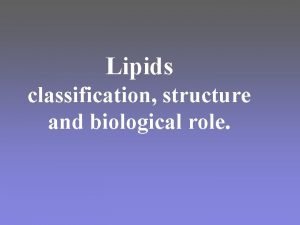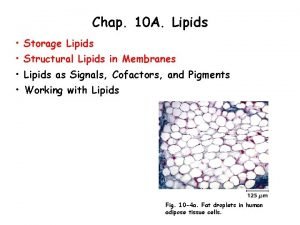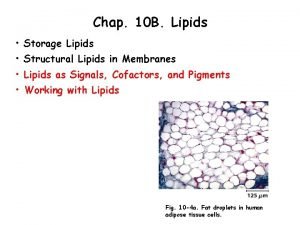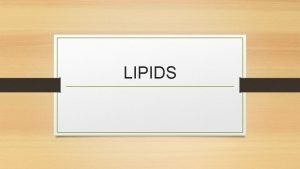Lipids Lipids Lipids a heterogeneous class of naturally




























- Slides: 28

Lipids • Lipids: Lipids a heterogeneous class of naturally occurring organic compounds (mainly esters) classified together on the basis of common solubility properties

Lipids • Lipids include – ESTERS – Triacylglycerols (triglycerides), phosphoacylglycerols (phospholipids), sphingolipids, glycolipids. – NON-ESTERS – cholesterol, steroid hormones, and bile acids – lipid-soluble vitamins, and prostaglandins






Waxes • Waxes are very water insoluble and high melting point. • They are widely distributed in nature as protective waterproof coatings on leaves, fruits, animal skin, fur, feathers and exoskeletons Prentice Hall c 2002 Chapter 9 8

Waxes • Esters of long-chain fatty acids and long chain monohydroxylic alcohols – from the Old English word weax = honeycomb

Triacylglycerols • Esters of glycerol with three fatty acids • Fatty acids are stored as neutral lipids, triaclyglycerols (TGs) • TGs are hydrophobic, stored in fat cells (adipocytes) Prentice Hall c 2002 Chapter 9 Structure of a triacylglycerol 10

Glycerophospholipids

Glycerophospholipids

Structures of glycerophospholipids Prentice Hall c 2002 Phosphatidylcholine (PC) Chapter 9 13

Structures of glycerophospholipids

Structures of glycerophospholipids Prentice Hall c 2002 Phosphatidylserine (PS) Chapter 9 15

Cardiolipin: • Two molecules of PA esterified through their phosphate groups to an additional molecule of glycerol is called cardiolipin

Importance of cardiolipin �Cardiolipin is found in bacteria and eukaryotes (inner mitochondrial membrane) �Cardiolipin is antigenic, and is recognized by antibodies raised against Treponema pallidum, the bacterium that causes syphilis

Sphingolipids • Sphingolipids - sphingosine is the backbone. Abundant in central nervous system tissues • Ceramides - fatty acyl group linked to sphingosine • Sphingomyelins - phosphocholine attached to ceramide • Cerebrosides - glycosphingolipids with one monosaccharide residue attached to ceramide • Galactosylcerebrosides - a single b-D-galactose as a polar head group • Gangliosides - contain oligosaccharide chains with N-acetylneuraminic acid (Neu. NAc) attached to a ceramide Prentice Hall c 2002 Chapter 9 18

(a) Sphingosine (b) Ceramides Prentice Hall c 2002 Chapter 9 19

Significance of Ceramide & sphingosine • Ceramide – A long-chain fatty acid is attached to the amino group of sphingosine through an amide linkage • Ceramides appear to be involved in the response to stress • sphingosine inhibits protein kinase C


Sphingomyelin • Amino alcohol sphingosine, rather than glycerol • The alcohol group at carbon 1 of sphingosine is esterified to phosphorylcholine • Sphingomyelin is an important constituent of the myelin of nerve fibers

Sphingomyelin degradation • Sphingomyelin is degraded in lysosomes by sphingomyelinase to give ceramide, • and ceramidase to give sphingosine • Niemann-Pick disease is due to sphingomyelinase deficiency

Glycolipids • Also known as glycosphingolipids • contain both carbohydrate and lipid components • Ceramides plus a long-chain fatty acid attached to the amino alcohol sphingosine �essential components of: �All membranes �Nerve cells

Glycolipids Significance �Glycosphingolipids are antigenic a source of blood group antigens �The carbohydrate portion of a glycolipid is the antigenic determinant �serve as cell surface receptors for cholera and tetanus toxins

• Structure of a galactocerebroside • Galactocerebroside—the most common cerebroside found in membranes • Glucocerebroside Prentice Hall c 2002 Chapter 9 26

Location • cerebrosides predominantly in the brain and peripheral nervous tissue

Ganglioside (sphingolipid) • found in the ganglion cells • Derivatives of ceramide oligosaccharides, and contain one or more molecules of NANA. • negatively charged at physiologic p. H provided by N-acetylneuraminic acid (NANA). • [NANA is also referred to as sialic acid. ] •
 V
V Heterogeneous lipids
Heterogeneous lipids Heterogeneous lipids
Heterogeneous lipids Homogeneous mixture and heterogeneous mixture class 9
Homogeneous mixture and heterogeneous mixture class 9 Heterogeneous class
Heterogeneous class Heterogeneous
Heterogeneous Why is vinegar a homogeneous mixture
Why is vinegar a homogeneous mixture Homogeneous vs heterogeneous
Homogeneous vs heterogeneous Elements, compounds and mixtures worksheet
Elements, compounds and mixtures worksheet Heterogeneous hypoechoic lesion in liver
Heterogeneous hypoechoic lesion in liver Heterogeneous aqueous systems
Heterogeneous aqueous systems Heterogeneous computing
Heterogeneous computing Colloid is a heterogeneous system
Colloid is a heterogeneous system Ctive
Ctive Heterogeneous mixture
Heterogeneous mixture Suspension heterogeneous mixture
Suspension heterogeneous mixture Decao
Decao Heterogeneous distributed database
Heterogeneous distributed database Foods that are heterogeneous mixtures
Foods that are heterogeneous mixtures Heterogeneous nucleation
Heterogeneous nucleation Oag: toward linking large-scale heterogeneous entity graphs
Oag: toward linking large-scale heterogeneous entity graphs Separating techniques of pizza
Separating techniques of pizza Is cake batter a mixture or pure substance
Is cake batter a mixture or pure substance Heterogeneous architecture presentation
Heterogeneous architecture presentation Pure compound
Pure compound Is raisin bran a heterogeneous mixture
Is raisin bran a heterogeneous mixture Is chunky peanut butter homogeneous or heterogeneous
Is chunky peanut butter homogeneous or heterogeneous Heterogeneous nucleation equation
Heterogeneous nucleation equation Heterogeneous catalyst
Heterogeneous catalyst
